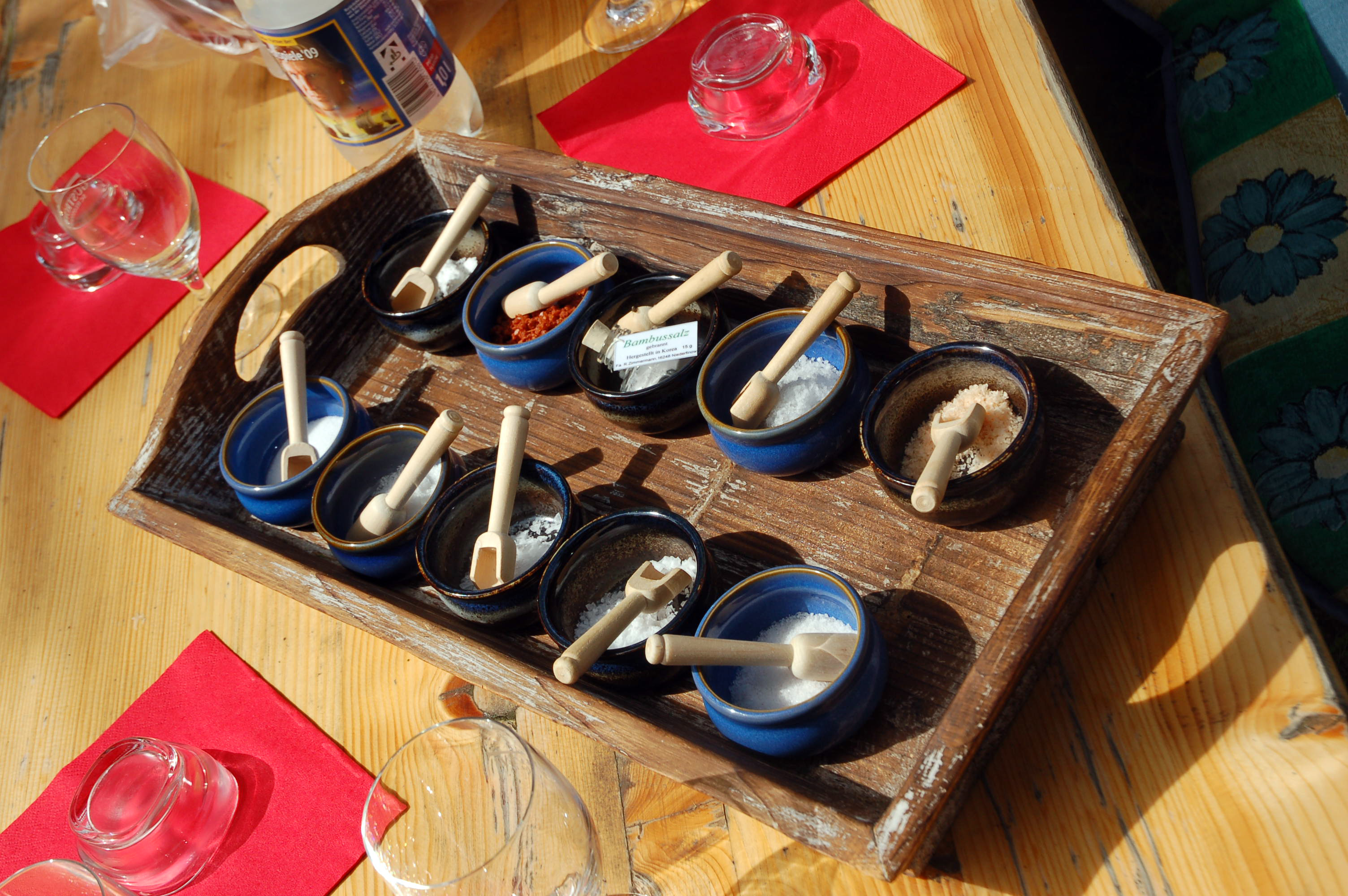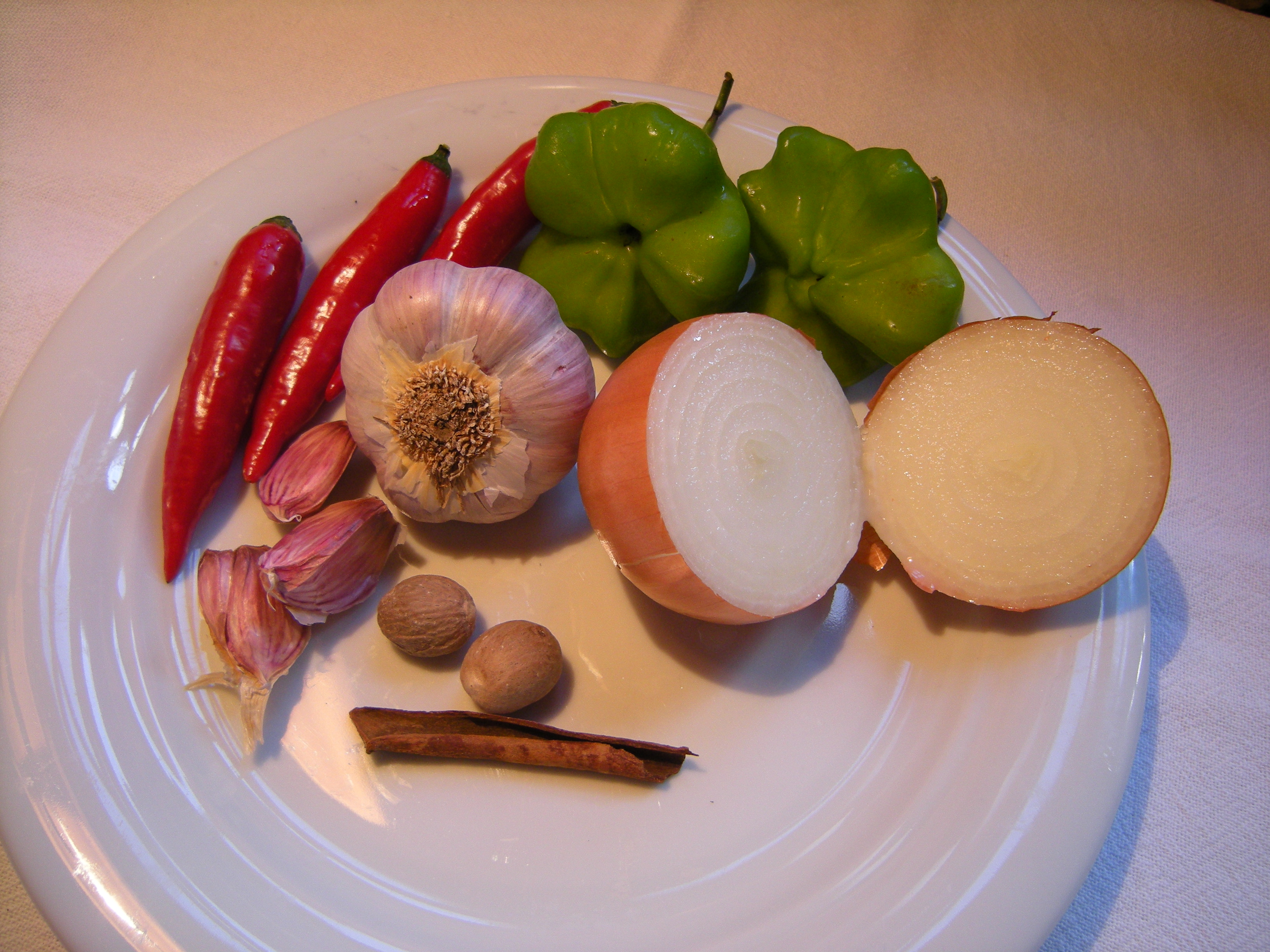Seasoning on:
[Wikipedia]
[Google]
[Amazon]
 Seasoning is the process of supplementing food via herbs, spices, salts, and/or sugar, intended to enhance a particular flavour.
Seasoning is the process of supplementing food via herbs, spices, salts, and/or sugar, intended to enhance a particular flavour.
(''Translated from the French, Librairie Larousse, Paris (1938)'') Salt may be used to draw out
 # ''Saline seasonings'' –
# ''Saline seasonings'' –
 # ''The pungents'' –
# ''The pungents'' –
 Seasoning is the process of supplementing food via herbs, spices, salts, and/or sugar, intended to enhance a particular flavour.
Seasoning is the process of supplementing food via herbs, spices, salts, and/or sugar, intended to enhance a particular flavour.
General meaning
Seasonings include herbs and spices, which are themselves frequently referred to as "seasonings". However, '' Larousse Gastronomique'' states that "to season and to flavor are not the same thing", insisting that seasoning includes a large or small amount of salt being added to a preparation.'' Larousse Gastronomique'' (1961), Crown Publishers(''Translated from the French, Librairie Larousse, Paris (1938)'') Salt may be used to draw out
water
Water (chemical formula ) is an inorganic, transparent, tasteless, odorless, and nearly colorless chemical substance, which is the main constituent of Earth's hydrosphere and the fluids of all known living organisms (in which it acts as ...
, or to magnify a natural flavor of a food making it richer or more delicate, depending on the dish. This type of procedure is akin to curing. For instance, sea salt (a coarser-grained salt) is rubbed into chicken
The chicken (''Gallus gallus domesticus'') is a domesticated junglefowl species, with attributes of wild species such as the grey and the Ceylon junglefowl that are originally from Southeastern Asia. Rooster or cock is a term for an adu ...
, lamb, and beef
Beef is the culinary name for meat from cattle (''Bos taurus'').
In prehistoric times, humankind hunted aurochs and later domesticated them. Since that time, numerous breeds of cattle have been bred specifically for the quality or quantit ...
to tenderize the meat and improve flavour. Other seasonings like black pepper
Black pepper (''Piper nigrum'') is a flowering vine in the family Piperaceae, cultivated for its fruit, known as a peppercorn, which is usually dried and used as a spice and seasoning. The fruit is a drupe (stonefruit) which is about in dia ...
and basil transfer some of their flavors to the food. A well-designed dish may combine seasonings that complement each other.
In addition to the choice of herbs and seasoning, the timing of when flavors are added will affect the food that is being cooked or otherwise prepared.
In some cultures, meat may be seasoned by pouring seasoning sauce over the dish at the table. A variety of seasoning techniques exist in various cultures. Seasoning means bringing out or intensifying the natural flavor of the food without changing it. Seasonings are usually added near the end of the cooking period. The most common seasonings are salt, pepper, and acids (such as lemon juice). When seasonings are used properly, they cannot be tasted; their job is to heighten the flavors of the original ingredients.
Researchers have found traces of garlic mustard seeds in prehistoric pots that also contained traces of other animals, making this the earliest recording of seasoning food.
Oil infusion
Infused oils are also used for seasoning. There are two methods for doing an infusion—hot and cold. Olive oil makes a good infusion base for some herbs, but tends to go rancid more quickly than other oils. Infused oils should be kept refrigerated. It is important to note that butter is not considered a seasoning.Escoffier
In '' Le Guide culinaire'', Auguste Escoffier (1903), '' Le Guide culinaire'', Editions Flammarion Auguste Escoffier divides seasoning and condiments into the following groups:Seasonings
 # ''Saline seasonings'' –
# ''Saline seasonings'' – salt
Salt is a mineral composed primarily of sodium chloride (NaCl), a chemical compound belonging to the larger class of salts; salt in the form of a natural crystalline mineral is known as rock salt or halite. Salt is present in vast quant ...
, spiced salt, saltpeter.
# ''Acid seasonings'' – plain vinegar (sodium acetate), or same aromatized with tarragon
Tarragon (''Artemisia dracunculus''), also known as estragon, is a species of perennial herb in the family Asteraceae. It is widespread in the wild across much of Eurasia and North America and is cultivated for culinary and medicinal purposes. ...
; ''verjuice
Verjuice ( ; from Middle French ''vertjus'' 'green juice') is a highly acidic juice made by pressing unripe grapes, crab-apples or other sour fruit. Sometimes lemon or sorrel juice, herbs or spices are added to change the flavour. In the ...
'', lemon and orange juices.
# ''Hot seasonings'' – peppercorns, ground or coarsely chopped pepper, or ''mignonette pepper''; paprika, curry
A curry is a dish with a sauce seasoned with spices, mainly associated with South Asian cuisine. In southern India, leaves from the curry tree may be included.
There are many varieties of curry. The choice of spices for each dish in trad ...
, cayenne, and mixed pepper spices.
# ''Spice seasonings'' – made by using essential oils like paprika, clove oil, etc.
Condiments
 # ''The pungents'' –
# ''The pungents'' – onion
An onion (''Allium cepa'' L., from Latin ''cepa'' meaning "onion"), also known as the bulb onion or common onion, is a vegetable that is the most widely cultivated species of the genus '' Allium''. The shallot is a botanical variety of the on ...
s, shallots, garlic
Garlic (''Allium sativum'') is a species of bulbous flowering plant in the genus '' Allium''. Its close relatives include the onion, shallot, leek, chive, Welsh onion and Chinese onion. It is native to South Asia, Central Asia and northeas ...
, chive
Chives, scientific name ''Allium schoenoprasum'', is a species of flowering plant in the family Amaryllidaceae that produces edible leaves and flowers. Their close relatives include the common onions, garlic, shallot, leek, scallion, an ...
s, and horseradish.
# ''Hot condiments'' – mustard, gherkins, capers, English sauces, such as Worcestershire sauce, ketchup, etc. and American sauces such as chili sauce, Tabasco, A1 Steak Sauce, etc.; the wines used in reductions and braisings; the finishing elements of sauces and soups.
# ''Fatty substances'' – most animal fats, butter
Butter is a dairy product made from the fat and protein components of churned cream. It is a semi-solid emulsion at room temperature, consisting of approximately 80% butterfat. It is used at room temperature as a spread, melted as a condim ...
, vegetable greases ( edible oils and margarine).
See also
* Condiment *Flavoring
A flavoring (or flavouring), also known as flavor (or flavour) or flavorant, is a food additive used to improve the taste or smell of food. It changes the perceptual impression of food as determined primarily by the chemoreceptors of the g ...
* List of culinary herbs and spices
* List of spice mixes
* Popcorn seasoning
References
{{Veganism and vegetarianism Cooking techniques Culinary terminology Spices